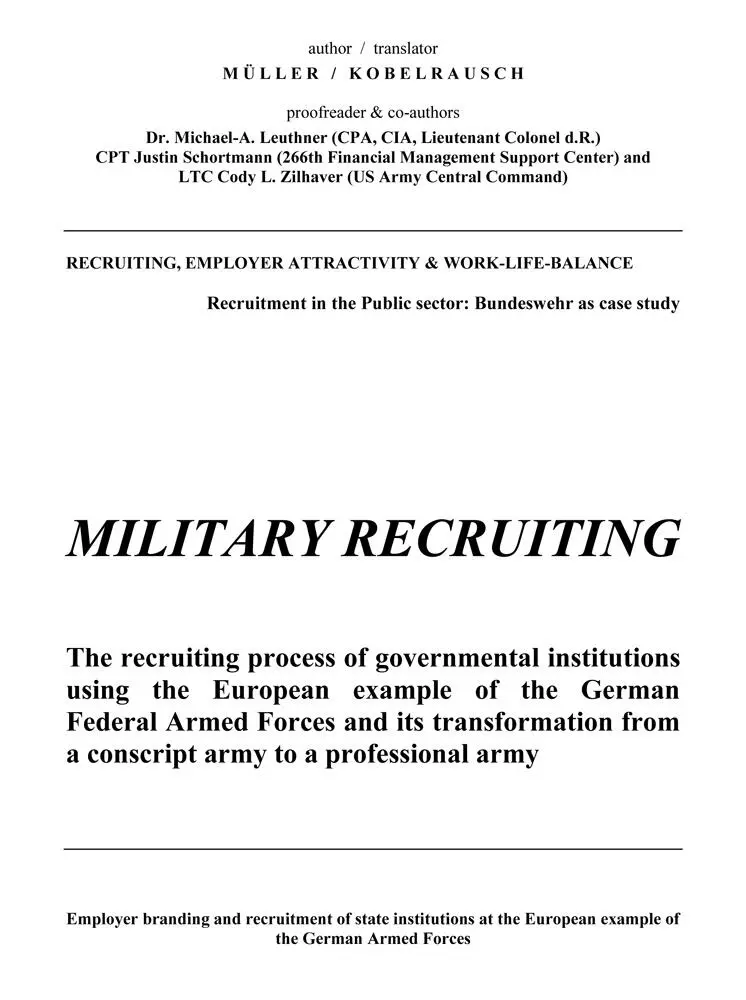
Key Words
Arbeitgeber Bundeswehr, Employers state, employers, employer-employee interaction, attractiveness as an employer, Employer image, employer self-image, employer perception, employees, employee self-image, job selection, attractiveness of the Bundeswehr as an employer, attractiveness perception of employers, popularity and attractiveness of an employer, professional army, occupation phases, Lifer (BS), applicants, assessment and orientation patterns of individuals over the Bundeswehr as an employer, Branding , Bundeswehr (BW), Bundeswehr and the public good "security", Bundeswehrverband (German Reservist Association, Corporate Attractiveness, DBwV, demographics, demographic change, demographics, demographic change, demographic strength, German Armed Forces German Armed Forces Association, Germany, own study, the onset of change in the labor market, Employee, Employer Attractiveness, Employer Branding, Employer, employment history, acquiring powers, acquiring human resources, labor force, shortage of skilled labor, volunteer army, salary, salary structure, Generation X, Generation Y, Generation Peak Point, global public good (GPG), global (public) goods , a global public good, global security, Green Paper, military service, recommendations Bundeswehr, Hessentagsarena study, Human Resource (HR) Human Resource Management (HRM), human resource, Image, Know Your Customer Principle (KYC) Know Your Employee principle (KYE) national defense, life cycle model, life cycle, market failures, military, employees, employee recruitment, template, sustainability, post-military era, NATO, public good issue, public goods and resources, public institutions, public good, personnel requirements, personnel requirements coverage, recruitment, recruiting, HR marketing, personnel marketing measures, staff recruitment, practical implications Bundeswehr, Public Service Motivation (PSM), recruiting, recruiting Relevance, reservists association, resources, self-image, security, soldier, government, armed forces, stress factors, study, talent management, total model of employer-employee interaction, Total Model, transformation, corporate attractiveness, imperfect markets, Association of reservists of the German Bundeswehr (VdRBw), comparative study, military service, military service, military service suspension, White Paper, Work-Life Balance (WLB), regular soldier, 2013, 2014, 2015, 2016

Impressum
Copyright: © 2016 Markus Müller
Publisher: epubli GmbH, Berlin, www.epubli.de
Contact: EmployerBrandingStudie@outlook.de
ISBN 978-3-7375-7933-9
First US-English Edition: MAY 2016

ISBN 978-3-7375-7933-9
(e)ISBN 978-3-7375-7934-6
Table of content
Key Words Key Words Arbeitgeber Bundeswehr, Employers state, employers, employer-employee interaction, attractiveness as an employer, Employer image, employer self-image, employer perception, employees, employee self-image, job selection, attractiveness of the Bundeswehr as an employer, attractiveness perception of employers, popularity and attractiveness of an employer, professional army, occupation phases, Lifer (BS), applicants, assessment and orientation patterns of individuals over the Bundeswehr as an employer, Branding , Bundeswehr (BW), Bundeswehr and the public good "security", Bundeswehrverband (German Reservist Association, Corporate Attractiveness, DBwV, demographics, demographic change, demographics, demographic change, demographic strength, German Armed Forces German Armed Forces Association, Germany, own study, the onset of change in the labor market, Employee, Employer Attractiveness, Employer Branding, Employer, employment history, acquiring powers, acquiring human resources, labor force, shortage of skilled labor, volunteer army, salary, salary structure, Generation X, Generation Y, Generation Peak Point, global public good (GPG), global (public) goods , a global public good, global security, Green Paper, military service, recommendations Bundeswehr, Hessentagsarena study, Human Resource (HR) Human Resource Management (HRM), human resource, Image, Know Your Customer Principle (KYC) Know Your Employee principle (KYE) national defense, life cycle model, life cycle, market failures, military, employees, employee recruitment, template, sustainability, post-military era, NATO, public good issue, public goods and resources, public institutions, public good, personnel requirements, personnel requirements coverage, recruitment, recruiting, HR marketing, personnel marketing measures, staff recruitment, practical implications Bundeswehr, Public Service Motivation (PSM), recruiting, recruiting Relevance, reservists association, resources, self-image, security, soldier, government, armed forces, stress factors, study, talent management, total model of employer-employee interaction, Total Model, transformation, corporate attractiveness, imperfect markets, Association of reservists of the German Bundeswehr (VdRBw), comparative study, military service, military service, military service suspension, White Paper, Work-Life Balance (WLB), regular soldier, 2013, 2014, 2015, 2016
Impressum Impressum Copyright: © 2016 Markus Müller Publisher: epubli GmbH, Berlin, www.epubli.de Contact: EmployerBrandingStudie@outlook.de ISBN 978-3-7375-7933-9 First US-English Edition: MAY 2016 ISBN 978-3-7375-7933-9 (e)ISBN 978-3-7375-7934-6
List of abbreviations
List of tables and figures
Foreword
Acknowledgement
1. Introduction
2. The public good problem
2.1 The Bundeswehr and the public good "security"
2.2 Definition and problem of public goods and resources
2.2.1 Definition
2.2.2. Problem
2.3 The provision of „security “
2.3.1 The term „security “
2.3.2 An imperfect market - (no) place for an army
2.3.3 Demographics strength, sustainability and recruitment requirements of German Armed Forces in the medium and long-term point of view
3. Personnel recruiting and employer attractiveness
3.1 The onset of change in the labor market
3.2 Conceptual framework approach to employers’ perception
3.2.1 Vocational phases of individuals
3.2.2 Employer branding & model framework of attractiveness perception by employers
3.2.3 Corporate Attractiveness as the attractiveness of the company
3.2.4 Employer Attractiveness as recruiting relevant aspect of corporate attractiveness
3.3 More detailed aspects in the context of popularity and attractiveness of an employer
3.3.1 Public Service Motivation (PSM)
3.3.2 Work-Life-Balance
3.3.3 Salary
3.4 Classification of the attractiveness of "Employer Bundeswehr"
3.5 Appropriate personnel marketing measures approach
4. Own study: A comparative study on evaluation and orientation patterns of individuals towards the Bundeswehr as an employer
4.1 Introduction to the method
4.2 Methodological part of the study
4.2.1 Participants and method
4.2.2 Measures
4.3 Results of the study
4.3.1 Descriptive analysis
4.3.2 Multivariate Analysis
5. Summary and conclusions
5.1 Results of the study and conclusion
5.2 Practical implications and recommendations for action
Читать дальше















